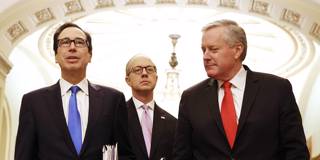In a rare moment of bipartisanship, congressional Republicans and Democrats have found plenty of common ground in designing an economic-policy response to the coronavirus pandemic. But unless that response re-balances the economy toward labor, the recovery will inevitably prove disappointing.
NEW YORK – Despite the deep polarization of American politics, there appears to be more agreement than disagreement over how to deal with the economic fallout from the COVID-19 pandemic. The US Federal Reserve is already pursing bold monetary-policy measures, and Congress is quickly working toward a large fiscal-stimulus package featuring government bailouts with equity stakes in private companies and one- or two-time cash infusions to households.
But this rare moment of bipartisanship will turn out to have been a missed opportunity if it does not also reverse the long decline of worker protections and collective-bargaining power in the United States. As Lawrence H. Summers of Harvard University and many others have shown, this trend has contributed significantly to the US economy’s stagnation in recent years, and it now threatens to undercut the next recovery.
Despite tightening labor markets since 2009, labor’s share of income has steadily and stubbornly fallen. Without a policy response that puts wages and economic security back on track with profits and productivity growth, a sudden drop in economic output will be inevitable. Worse, the current design of the bipartisan response would allow for a further consolidation of monopoly and monopsony power, leading to further labor repression and stagnation. Without measures to strengthen automatic stabilizers, social insurance programs, and workers’ bargaining power, the increased supply of labor from rising unemployment will suppress many workers’ reservation wage (the minimum pay that a worker can or will accept).

NEW YORK – Despite the deep polarization of American politics, there appears to be more agreement than disagreement over how to deal with the economic fallout from the COVID-19 pandemic. The US Federal Reserve is already pursing bold monetary-policy measures, and Congress is quickly working toward a large fiscal-stimulus package featuring government bailouts with equity stakes in private companies and one- or two-time cash infusions to households.
But this rare moment of bipartisanship will turn out to have been a missed opportunity if it does not also reverse the long decline of worker protections and collective-bargaining power in the United States. As Lawrence H. Summers of Harvard University and many others have shown, this trend has contributed significantly to the US economy’s stagnation in recent years, and it now threatens to undercut the next recovery.
Despite tightening labor markets since 2009, labor’s share of income has steadily and stubbornly fallen. Without a policy response that puts wages and economic security back on track with profits and productivity growth, a sudden drop in economic output will be inevitable. Worse, the current design of the bipartisan response would allow for a further consolidation of monopoly and monopsony power, leading to further labor repression and stagnation. Without measures to strengthen automatic stabilizers, social insurance programs, and workers’ bargaining power, the increased supply of labor from rising unemployment will suppress many workers’ reservation wage (the minimum pay that a worker can or will accept).